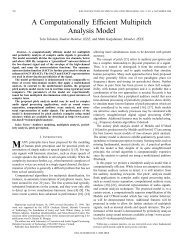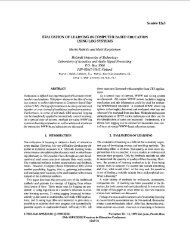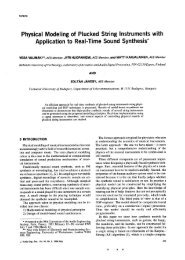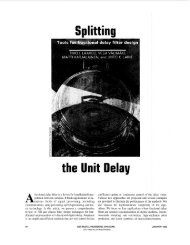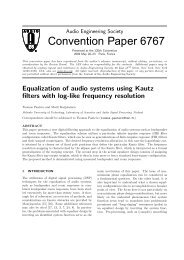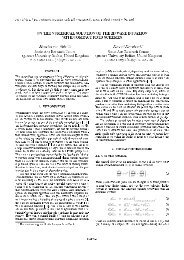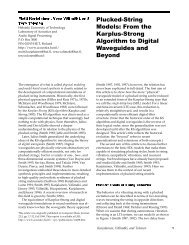The sonification of numerical fluid flow simulations
The sonification of numerical fluid flow simulations
The sonification of numerical fluid flow simulations
Create successful ePaper yourself
Turn your PDF publications into a flip-book with our unique Google optimized e-Paper software.
Proceedings <strong>of</strong> the 2001 International Conference on Auditory Display, Espoo, Finland, July 29-August 1, 2001When the <strong>flow</strong> is fully developed, the transverse velocity componentÚ vanishes, and the pressure Ô changes only linearly with Ü:¡Ô ½¾ÙÑ¡Ü ¾ (7)which gives the pressure drop ¡Ô over some Ü-direction length¡Ü, and where the viscosity is in this case 1 kg/ms.A coarse ¢ evenly spaced grid was used, yielding a total <strong>of</strong> ¢ ¾internal or “live” cells at which the values <strong>of</strong> Ù, Ú andÔ are updated at each iteration by the solver. With this very simpleconfiguration, the solver converges in about 20 iterations.3.1. Sonification Strategy<strong>The</strong> purpose <strong>of</strong> this <strong>sonification</strong> was to gain insight into the solverby listening to its progress in real time. To accomplish this, 5 sineoscillators were set up to correspond to each column <strong>of</strong> “live” gridpoints. As the solver (for Ù, Ú then Ô) sweeps through the domainfrom left to right, first the column at ½sounds, from ½ ,with slight arpeggiation, and so on, with a slight pause for eachcolumn, through . Thus, each iteration produces 25 notes pervariable, for 75 total.In most CFD <strong>simulations</strong>, general trends and <strong>flow</strong> behaviorare known to the engineer in advance <strong>of</strong> the calculation. In this<strong>sonification</strong>, the pitch strategy for each variable was selected sothat the anticipated behavior in the <strong>flow</strong> direction could be “heard”:1. Development <strong>of</strong> Ù from a flat to a parabolic pr<strong>of</strong>ile.2. Vanishing <strong>of</strong> Ú.3. Linear decrease <strong>of</strong> Ô in the <strong>flow</strong> direction.3.1.1. Pitch Mapping<strong>The</strong> values <strong>of</strong> Ù range from uniformly 1.0 at the inlet (near ½) to values in the range ¼¼ Ù ½ at the <strong>flow</strong> exit (near ). <strong>The</strong> initial guess for Ù throughout the domain is 0.0. Asthe solution iterates, values <strong>of</strong> Ù well in excess <strong>of</strong> 1.5 may result.<strong>The</strong> values <strong>of</strong> Ù were mapped to pitch and scaled so that a value <strong>of</strong>Ù ½would yield 440 Hz, with 55 Hz set as the minimum valuefor values <strong>of</strong> Ù¼½¾.<strong>The</strong> values <strong>of</strong> Ú range from approximately 0.1 near the inletto very small numbers near the exit (the initial guess throughoutthe <strong>flow</strong> field, as for Ù, isÚ ¼¼). <strong>The</strong> values <strong>of</strong> Ú were alsomapped to pitch, but scaled up so that a value <strong>of</strong> Ú ½ wouldyield 8400 Hz. All nodes with values <strong>of</strong> Ú about ¼¼ weremapped to a major triad with pitches (150, 300, 375, 450) Hz, fornodes ¾.<strong>The</strong> values <strong>of</strong> Ô in incompressible <strong>fluid</strong> <strong>flow</strong> are generally calculatedrelative to some <strong>numerical</strong>ly convenient reference value,in this case Ô Ö ½¼ Pa at node ´ µ ´½ ½µ. Values <strong>of</strong> Ô arecalculated relative to Ô´½ ½µ, where the significant pressure informationis the ¡Ô between nodes which drives the <strong>flow</strong>. Using thisscheme, the values <strong>of</strong> Ô range from ¼ Ô ½¼. <strong>The</strong> localvalue <strong>of</strong> Ô was added to a different major triad (100, 200, 300, 400,500) Hz for ½. Because the values <strong>of</strong> the pressure arefairly uniform at each location, one hears, for this scheme, a succession<strong>of</strong> major triads whose pitch either increases, decreases orstays the same.3.1.2. Envelope<strong>The</strong> envelope (attack, sustain, decay) characteristics were derivedfrom the matrix coefficients for each variable at each node:Ø ½ Æ ½ Æ È Ø ¾ Ë ¾ Ë È Ø ¿ (8) ¿ È Ø Ï Ï È Ø ½¼ ¼¼Equations 8 represent a 5 frame envelope where ½ is the amplitude<strong>of</strong> the first frame, Ø ½ is its rise time, etc. <strong>The</strong> values for thefifth frame are set to constant values <strong>of</strong> 1.0 and 0.0 respectively toensure that the oscillator will turn <strong>of</strong>f. <strong>The</strong> values <strong>of</strong> Ø ½ were constrainedto be at least 0.05 secs, to avoid clicks due to zero-lengthframes. Division <strong>of</strong> all neighbor coefficients Æ, etc. by the centercoefficient È ensures that ¼¼ Ò ½¼, since the centercoefficient is always greater in magnitude than its correspondingneighbors.3.1.3. DurationIn general, as the solver proceeds and makes available the latestvalues <strong>of</strong> variable and coefficient at each node, the mapped pitchesand envelopes were queued to the oscillators. However, to makethe sonic result more intelligible, some delays were added. Firstly,very slight delays were added between nodes in each column, toproduce something like an arpeggiated chord. Secondly, a longerdelay was added at the conclusion <strong>of</strong> each column, before proceedingto the next column. Thirdly, at the conclusion <strong>of</strong> the <strong>sonification</strong><strong>of</strong> a variable at all 25 nodes, a longer delay was added proportionalto the global error calculated for that variable. Thus, as thecalculation proceeds, this delay decreases as the error is reduced.Finally, at the conclusion <strong>of</strong> a single iteration, a longer delay wasadded. It is thus possible for the listener to distinguish, based onthe delay between notes, the different stages <strong>of</strong> the calculation.3.1.4. TimbreNo specific timbral mapping was attempted, since a sine oscillatorwas used for all notes. However, because each note was given aunique envelope, some striking timbral differences resulted, mainlyfrom different attack times.4. RESULTS<strong>The</strong> parameter/variable mapping choices described in the previoussection had the following effects:¯ <strong>The</strong> Ù velocity <strong>sonification</strong> captured the oscillations <strong>of</strong> thesolver well. <strong>The</strong> solver initial guess <strong>of</strong> Ù ¼was followed,at the second iteration, by values considerably overshootingthe final result. This behavior sounded like a sequenceICAD01-48





